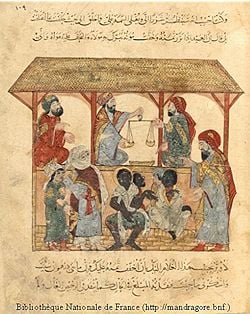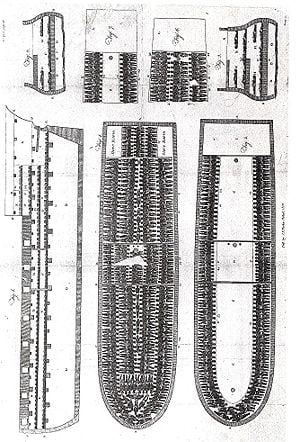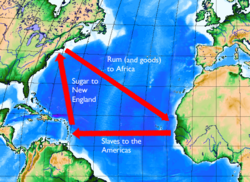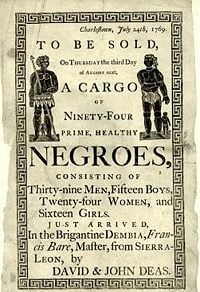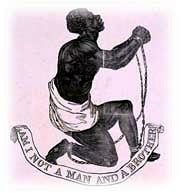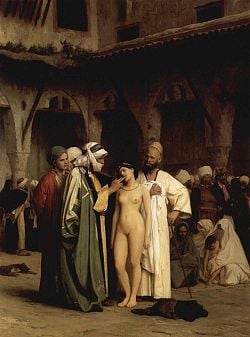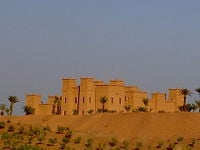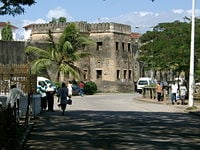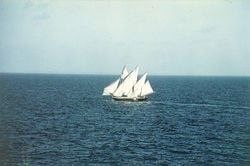Slave trade
The slave trade has been, and continues to be, an economic commodity based on human life. In the twenty-first century, this practice became known as "human trafficking," taking place in a black market operating outside recognized legal systems. In other eras, slave trade was conducted openly and legally.
Slavery has been a part of human civilization for thousands of years up to the present. It was practiced in ancient Egypt, ancient Greek society, the Roman Empire, in the Middle East, Europe, and the Americas. In the United States, a bitter civil war was fought over the issue of slavery and slave trade.
The primary reason for the enterprise of slave trade and human trafficking is found in the huge profits that derive from the use of power over vulnerable and/or weaker populations of people to meet the demand of the international marketplace. As humankind becomes more aware of the need to recognize all people as members of the same human family, treating each other with love and respect, it can be expected that slavery will finally disappear and the slave trade will be no more.
Abolition:
Introduction
Trafficking in human beings is the commercial trade ("smuggling") of human beings, who are subjected to involuntary acts such as begging, sexual exploitation (such as prostitution), or forced labor (such as working in sweatshops). Trafficking involves a process of using physical force, fraud, deception, or other forms or coercion or intimidation to obtain, recruit, harbor, and transport people.
Human trafficking differs from people smuggling. In the latter, people voluntarily request smuggler's service for fees and there is no deception involved in the (illegal) agreement. On arrival at their destination, the smuggled person is either free, or is required to work under a job arranged by the smuggler until the debt is repaid. On the other hand, the trafficking victim is enslaved, or the terms of their debt bondage are fraudulent or highly exploitative. The trafficker takes away the basic human rights of the victim, sometimes luring them by false promises or physically forcing them into servitude.
Trafficked persons usually come from the poorer regions of the world, where opportunities are limited and are often from the most vulnerable in society, such as runaways, refugees, or other displaced persons. This is especially common in post-conflict situations, such as Kosovo and Bosnia and Herzegovina, although they may also come from any social background, class, or race. People who are seeking entry to other countries may be picked up by traffickers, and misled into thinking that they will be free after being smuggled across the border. In some cases, they are captured through slave raiding, although this is increasingly rare. Other cases may involve parents who may sell children to traffickers in order to pay off debts or gain income.
Women, who form the majority of trafficking victims, are particularly at risk from potential kidnappers who exploit lack of opportunities, promise good jobs or opportunities for study, and then force the victims to be prostitutes. Through agents and brokers who arrange the travel and job placements, women are escorted to their destinations and delivered to the employers. Upon reaching their destinations, some women learn that they have been deceived about the nature of the work they will do; most have been lied to about the financial arrangements and conditions of their employment; and all find themselves in coercive and abusive situations from which escape is both difficult and dangerous.
The main motives of a woman (and in some cases an underage girl) to accept an offer from a trafficker is for better financial opportunities for themselves or their family. In many cases traffickers initially offer "legitimate" work. The main types of work offered are in the catering and hotel industry, in bars and clubs, au pair work or to study. Offers of marriage are sometimes used by traffickers as well as threats, intimidation, and kidnapping. In the majority of cases, prostitution is their final destination. Prostitutes may also become victims of human trafficking. Some women know they will be working as prostitutes, but they have a too rosy picture of the circumstances and the conditions of the work in the country of destination.[1]
Many women are forced into the sex trade after answering false advertisements and others are simply kidnapped. Thousands of children are sold into the global sex trade every year. Oftentimes they are kidnapped or orphaned, and sometimes they are actually sold by their own families. These children often come from Asia, Africa, and South America.
Traffickers mostly target developing nations where the women are desperate for jobs. The women are often so poor that they can not afford things like food and health care. When the women are offered a position as a nanny or waitress, they often jump to the opportunity.
Men are also at risk of being trafficked for unskilled work predominantly involving hard labor. Children are also trafficked for both labor exploitation and sexual exploitation.
Slave trade in antiquity
Slavery has been known throughout human history in numerous societies around the world. No clear or formal timeline delineates the formation of slavery. The earliest records show evidence of slavery, such as the Code of Hammurabi, which refers to slavery as an already established institution. By modern standards, the exploitation of women in some ancient cultures might also be identified as slavery. Slavery, in this case, refers to the systematic exploitation of labor for work (which can include sexual services).
The earliest contract for the sale of a slave thus far known to us from comes from thirteenth century B.C.E. Egypt. Despite this, over the course of a thousand years, an exact word that distinguished "slaves" from "captives" did not exist.
Slavery in the ancient world was closely tied to warfare; Greek and Roman captors frequently forced their prisoners of war into slavery, often as manual laborers in military, civil engineering, or agricultural projects, or sometimes as household servants.
Aristotle regarded the relationship of master and slave in the same category as husband and wife and father and children. In Politics, he called these the three fundamental social expressions of relationship between rulers and ruled in any organized society. The Stoics of Greece spoke out against the injustice and cruelty of slavery and Aristotle's vies of what was necessary in a genuinely civilized society.[2]
In the New Testament, it is recorded that Jesus went to see the sick slave of a Roman centurion at Capernaum, and the Apostle Paul wrote of slavery in his letter to the Galatians.
In ancient Greco-Roman times, slavery was related to the practice of infanticide. Unwanted infants were exposed to nature to die and slave traders often found these abandoned infants and brought them up in an atmosphere of slavery and prostitution. Justin Martyr condemned the abandonment of infants because the child might die and, most importantly, he might fall into the wrong hands:
But as for us, we have been taught that to expose newly-born children is the part of wicked men; and this we have been taught lest we should do any one an injury, and lest we should sin against God, first, because we see that almost all so exposed (not only the girls, but also the males) are brought up to prostitution.[3]
Historical development in Europe and the Americas
The transatlantic slave trade originated as a shortage of labor in the American colonies and later the United States. The first slaves used by European colonizers were indigenous peoples of the Americas, "Indian" peoples, but they were not numerous enough and were quickly decimated by European diseases, agricultural breakdown, and harsh regime. It was also difficult to get Europeans to immigrate to the colonies, despite incentives such as indentured servitude or even distribution of free land (mainly in the English colonies that became the United States). Massive amounts of labor were needed, initially for mining, and soon even more for the plantations in the labor-intensive growing, harvesting and semi-processing of sugar (also for rum and molasses), cotton and other prized tropical crops which could not be grown profitably—in some cases, could not be grown at all—in the colder climate of Europe. It was also cheaper to import these goods from American colonies than from regions within the Ottoman Empire. To meet this demand for labor, European traders thus turned to Western Africa, part of which became known as "the slave coast," and later Central Africa into a major source of fresh slaves.
The first Europeans to use African slaves in the New World were the Spaniards who sought auxiliaries for their conquest expeditions and laborers on islands such as Cuba and Hispaniola (now Haiti-Dominican Republic) where the alarming decline in the native population had spurred the first royal laws protecting the native population, the Laws of Burgos (1512-1513).
After Portugal had succeeded in establishing sugar plantations in northern Brazil in the mid-sixteenth century, Portuguese merchants on the West African coast began to supply enslaved Africans to the sugar planters there. While at first these planters relied almost exclusively on the native Tupani for slave labor, a titanic shift toward Africans took place after 1570 following a series of epidemics which decimated the already destabilized Tupani communities. By 1630, Africans had replaced the Tupani as the largest contingent of labor on Brazilian sugar plantations, heralding equally the final collapse of the European medieval household tradition of slavery, the rise of Brazil as the largest single destination for enslaved Africans, and sugar as the reason that roughly 84 percent of these Africans were shipped to the New World.
As Great Britain rose in naval power and controlled more of the Americas, they became the leading slave traders, mostly operating out of Liverpool and Bristol. Other British cities also profited from the slave trade. Birmingham was the largest gun-producing city in Britain at the time, and guns were traded for slaves. Seventy-five percent of all sugar produced in the plantations came to London to supply the highly lucrative coffee houses there.
New World destinations
African slaves were brought to Europe and the Americas to supply cheap labor. Central America only imported around 200,000. Europe topped this number at 300,000, North America, however, imported 500,000. The Caribbean was the second largest consumer of slave labor at four million. South America, with Brazil taking most of the slaves, imported 4.5 million before the end of the slave trade.
The slave trade was part of the triangular Atlantic trade, then probably the most important and profitable trading route in the world. Ships from Europe would carry a cargo of manufactured trade goods to Africa. They exchanged the trade goods for slaves whom they would transport to the Americas, where they sold the slaves and picked up a cargo of agricultural products, often produced with slave labor, for Europe. The value of this trade route was that a ship could make a substantial profit on each leg of the voyage. The route was also designed to take full advantage of prevailing winds and currents: the trip from the West Indies or the southern U.S. to Europe would be assisted by the Gulf Stream; the outward bound trip from Europe to Africa would not be impeded by the same current.
Even though since the Renaissance some ecclesiastics actively pleaded slavery to be against Christian teachings, others supported the economically opportune slave trade by church teachings and the introduction of the concept of the black man's and white man's separate roles: black men were expected to labor in exchange for the blessings of European civilization, including Christianity.
Economics of slavery
Slavery was involved in some of the most profitable industries of the time: 70 percent of the slaves brought to the new world were used to produce sugar, the most labor intensive crop. The rest were employed harvesting coffee, cotton, and tobacco, and in some cases in mining. The West Indian colonies of the European powers were some of their most important possessions, so they went to extremes to protect and retain them. For example, at the end of the Seven Years' War in 1763, France agreed to cede the vast territory of New France to the victors in exchange for keeping the minute Antillian island of Guadeloupe (still a French overseas département).
Slave trade profits have been the object of many fantasies. Returns for the investors were not actually absurdly high (around six percent in France in the eighteenth century), but they were higher than domestic alternatives (in the same century, around five percent). Risks—maritime and commercial—were important for individual voyages. Investors mitigated it by buying small shares of many ships at the same time. In that way, they were able to diversify a large part of the risk away. Between voyages, ship shares could be freely sold and bought. All these made slave trade a very interesting investment (Daudin 2004).
End of the Atlantic slave trade
In Britain and in other parts of Europe, opposition developed against the slave trade. Led by the Religious Society of Friends (Quakers) and establishment Evangelicals such as William Wilberforce, the movement was joined by many and began to protest against the trade, but they were opposed by the owners of the colonial holdings. Denmark, which had been very active in the slave trade, was the first country to ban the trade through legislation in 1792, which took effect in 1803. Britain banned the slave trade in 1807, imposing stiff fines for any slave found aboard a British ship. That same year the United States banned the importation of slaves. The British Royal Navy, which then controlled the world's seas, moved to stop other nations from filling Britain's place in the slave trade and declared that slaving was equal to piracy and was punishable by death.
For the British to end the slave trade, significant obstacles had to be overcome. In the eighteenth century, the slave trade was an integral part of the Atlantic economy: the economies of the European colonies in the Caribbean, the American colonies, and Brazil required vast amounts of man power to harvest the bountiful agricultural goods. In 1790, the British West Indies islands such as Jamaica and Barbados had a slave population of 524,000 while the French had 643,000 in their West Indian possessions. Other powers such as Spain, the Netherlands, and Denmark had large numbers of slaves in their colonies as well. Despite these high populations more slaves were always required.
Harsh conditions and demographic imbalances left the slave population with well below replacement fertility levels. Between 1600 and 1800, the English imported around 1.7 million slaves to their West Indian possessions. The fact that there were well over a million fewer slaves in the British colonies than had been imported to them illustrates the conditions in which they lived.
British influence
After the British ended their own slave trade, they felt forced by economics to induce other nations to do the same; otherwise, the British colonies would become uncompetitive with those of other nations. The British campaign against the slave trade by other nations was an unprecedented foreign policy effort. Denmark, a small player in the international slave trade, and the United States banned the trade during the same period as Great Britain. Other small trading nations that did not have a great deal to give up, such as Sweden, quickly followed suit, as did the Dutch, who were also by then a minor player.
Four nations objected strongly to surrendering their rights to trade slaves: Spain, Portugal, Brazil (after its independence), and France. Britain used every tool at its disposal to try to induce these nations to follow its lead. Portugal and Spain, which were indebted to Britain after the Napoleonic Wars, slowly agreed to accept large cash payments to first reduce and then eliminate the slave trade. By 1853, the British government had paid Portugal over three million pounds and Spain over one million pounds in order to end the slave trade. Brazil, however, did not agree to stop trading in slaves until Britain took military action against its coastal areas and threatened a permanent blockade of the nation's ports in 1852.
For France, the British first tried to impose a solution during the negotiations at the end of the Napoleonic Wars, but Russia and Austria did not agree. The French people and government had deep misgivings about conceding to Britain's demands. Britain demanded that other nations ban the slave trade and that they had the right to police the ban. The Royal Navy had to be granted permission to search any suspicious ships and seize any found to be carrying slaves, or equipped for doing so. It is especially these conditions that kept France involved in the slave trade for so long. While France formally agreed to ban the trading of slaves in 1815, they did not allow Britain to police the ban, nor did they do much to enforce it themselves. Thus a large black market in slaves continued for many years. While the French people had originally been as opposed to the slave trade as the British, it became a matter of national pride that they not allow their policies to be dictated to them by Britain. Also such a reformist movement was viewed as tainted by the conservative backlash after the French Revolution. The French slave trade thus did not end until 1848.
Arab Slave Trade
The Arab slave trade refers to the practice of slavery in the Arab world. The term "Arab" is inclusive, and traders were not exclusively Muslim, nor exclusively Arab: Persians, Berbers, Indians, Chinese and black Africans were involved in this to a greater or lesser degree.
The slave trade went to different destinations from the transatlantic slave trade, supplying African slaves to the Islamic world, which at its peak stretched over three continents from the Atlantic (Morocco, Spain) to India and eastern China.
A recent and controversial topic
The history of the slave trade has given rise to numerous debates amongst historians. Firstly, specialists are undecided on the number of Africans taken from their homes; this is difficult to resolve because of a lack of reliable statistics: there was no census system in medieval Africa. Archival material for the transatlantic trade in the sixteenth to eighteenth centuries may seem more useful as a source, yet these record books were often falsified. Historians have to use imprecise narrative documents to make estimates which must be treated with caution: Luiz Felipe de Alencastro[4] states that there were eight million slaves taken from Africa between the eighth and nineteenth centuries along the Oriental and the Trans-Saharan routes. Olivier Pétré-Grenouilleau has put forward a figure of 17 million African people enslaved (in the same period and from the same area) on the basis of Ralph Austen's work.[5] Paul Bairoch suggests a figure of 25 million African people subjected to the Arab slave trade, as against 11 million that arrived in the Americas from the transatlantic slave trade.[6]
Another obstacle to a history of the Arab slave trade is the limitations of extant sources. There exist documents from non-African cultures, written by educated men in Arabic, but these only offer an incomplete and often condescending look at the phenomenon. For some years there has been a huge amount of effort going into historical research on Africa. Thanks to new methods and new perspectives, historians can interconnect contributions from archaeology, numismatics, anthropology, linguistics, and demography to compensate for the inadequacy of the written record.
In Africa, slaves taken by African owners were often captured, either through raids or as a result of warfare, and frequently employed in manual labor by the captors. Some slaves were traded for goods or services to other African kingdoms.
The Arab slave trade from East Africa is one of the oldest slave trades, predating the European transatlantic slave trade by hundreds of years.[7] Male slaves were employed as servants, soldiers, or laborers by their owners, while female slaves, mostly from Africa, were long traded to the Middle Eastern countries and kingdoms by Arab and Oriental traders, some as female servants, others as sexual slaves. Arab, African, and Oriental traders were involved in the capture and transport of slaves northward across the Sahara desert and the Indian Ocean region into the Middle East, Persia, and the Indian subcontinent. From approximately 650 C.E. until around 1900 C.E., as many African slaves may have crossed the Sahara Desert, the Red Sea, and the Indian Ocean as crossed the Atlantic, and perhaps more. The Arab slave trade continued in one form or another into the early 1900s. Historical accounts and references to slave-owning nobility in Arabia, Yemen and elsewhere are frequent into the early 1920s.[7]
Thus, this earliest slave trade in the Indian Ocean, Red Sea, and Mediterranean pre-dates the arrival of any significant number of Europeans on the African continent.[8][7]
The Islamic world
Islam appeared in the seventh century C.E. In the next hundred years it was quickly diffused throughout the Mediterranean area, spread by Arabs who had conquered North Africa after its long occupation by the Berbers; they extended their rule to the Iberian peninsula where they replaced the Visigoth kingdom. Arabs also took control of western Asia from Byzantium and from the Sassanid Persians. These regions therefore had a diverse range of different peoples, and their knowledge of slavery and a trade in African slaves went back to Antiquity.
The framework of Islamic civilization was a well-developed network of towns and oasis trading centers with the market (souk, bazaar) at its heart. These towns were inter-connected by a system of roads crossing semi-arid regions or deserts. The routes were traveled by convoys, and black slaves formed part of this caravan traffic.
Africa: eighth through nineteenth centuries
In the eighth century C.E., Africa was dominated by Arab-Berbers in the north. Islam moved southwards along the Nile and along the desert trails.
The Sahara was thinly populated. Nevertheless, since antiquity there had been cities living on a trade in salt, gold, slaves, cloth, and on agriculture enabled by irrigation: Tahert, Oualata, Sijilmasa, Zaouila, and others. They were ruled by Arab or Berber chiefs (Tuaregs). Their independence was relative and depended on the power of the Maghrebi and Egyptian states.
In the Middle Ages, sub-Saharan Africa was called Sûdân in Arabic, meaning "land of the Blacks." It provided a pool of manual labor for North Africa and Saharan Africa. This region was dominated by certain states: the Ghana Empire, the Empire of Mali, the Kanem-Bornu Empire.
In eastern Africa, the coasts of the Red Sea and Indian Ocean were controlled by native Muslims, and Arabs were important as traders along the coasts. Nubia had been a "supply zone" for slaves since Antiquity. The Ethiopian coast, particularly the port of Massawa and Dahlak Archipelago, had long been a hub for the exportation of slaves from the interior, even in Aksumite times. The port and most coastal areas were largely Muslim, and the port itself was home to a number of Arab and Indian merchants.[9]
The Solomonic dynasty of Ethiopia often exported Nilotic slaves from their western borderland provinces, or from newly conquered or reconquered Muslim provinces.[10] Native Muslim Ethiopian sultanates exported slaves as well, such as the sometimes independent sultanate of Adal.[11] On the coast of the Indian Ocean too, slave-trading posts were set up by Arabs and Persians. The archipelago of Zanzibar, along the coast of present-day Tanzania, is undoubtedly the most notorious example of these trading colonies.
East Africa and the Indian Ocean continued as an important region for the Oriental slave trade up until the nineteenth century. Livingstone and Stanley were then the first Europeans to penetrate to the interior of the Congo basin and to discover the scale of slavery there. The Arab Tippo Tip extended his influence and made many people slaves. After Europeans had settled in the Gulf of Guinea, the trans-Saharan slave trade became less important. In Zanzibar, slavery was abolished late, in 1897, under Sultan Hamoud bin Mohammed.
The rest of Africa had no direct contact with Muslim slave-traders.
Aims of the slave trade and slavery
Economic motives for slave trading were the most obvious. The trade resulted in large profits for those who were running it. Several cities became rich and prospered thanks to the traffic in slaves, both in the Sûdân region and in East Africa. In the Sahara desert, chiefs launched expeditions against pillagers looting the convoys. The kings of medieval Morocco had fortresses constructed in the desert regions which they ruled, so they could offer protected stopping places for caravans. The Sultan of Oman transferred his capital to Zanzibar, since he had understood the economic potential of the eastward slave trade.
There were also social and cultural reasons for the trade: in sub-Saharan Africa, possession of slaves was a sign of high social status. In Arab-Muslim areas, harems needed a "supply" of women.
Finally, it is impossible to ignore the religious and racist dimension of this trade. Punishing bad Muslims or pagans was held to be an ideological justification for enslavement: the Muslim rulers of North Africa, the Sahara and the Sahel sent raiding parties to persecute infidels: in the Middle Ages, Islamisation was only superficial in rural parts of Africa.
Racist opinions recurred in the works of Arab historians and geographers: so in the fourteenth century C.E. Ibn Khaldun could write "[T]he Negro nations are, as a rule, submissive to slavery, because (Negroes) have little that is (essentially) human and possess attributes that are quite similar to those of dumb animals."[12]
Geography of the slave trade
"Supply" zones
Merchants of slaves for the Orient stocked up in Europe. Danish merchants had bases in the Volga region and dealt in Slavs with Arab merchants. Circassian slaves were conspicuously present in the harems and there were many odalisques from that region in the paintings of Orientalists. Non-Islamic slaves were valued in the harems, for all roles (gate-keeper, servant, odalisque, houri, musician, dancer, court dwarf).
In ninth-century Baghdad, the caliph, Al-Amin owned about seven thousand black eunuchs (who were completely emasculated) and four thousand white eunuchs (who were castrated).[13] In the Ottoman Empire, the last black eunuch, the slave sold in Ethiopia named Hayrettin Effendi, was freed in 1918. The slaves of Slavic origin in Al-Andalus came from the Varangians who had captured them. They were put in the caliph's guard and gradually took up important posts in the army (they became saqaliba), and even went to take back taifas after the civil war had led to an implosion of the Western Caliphate. Columns of slaves feeding the great harems of Cordoba, Seville and Grenada were organized by Jewish merchants (mercaderes) from Germanic countries and parts of Northern Europe not controlled by the Carolingian Empire. These columns crossed the Rhône valley to reach the lands to the south of the Pyrenees.
At sea, Barbary pirates joined in this traffic when they could capture people by boarding ships or by incursions into coastal areas.
Nubia, Ethiopia and Abyssinia were also "exporting" regions: in the fifteenth century, there were Abyssinian slaves in India where they worked on ships or as soldiers. They eventually rebelled and took power.
The Sudan region and Saharan Africa formed another "export" area, but it is impossible to estimate the scale, since there is a lack of sources with figures.
Finally, the slave traffic affected eastern Africa, but the distance and local hostility slowed down this section of the Oriental trade.
Routes
Caravan trails, set up in the ninth century, went past the oases of the Sahara; travel was difficult and uncomfortable for reasons of climate and distance. Since Roman times, long convoys had transported slaves as well as all sorts of products to be used for barter. To protect against attacks from desert nomads, slaves were used as an escort. Anyone who slowed down the progress of the caravan were killed.
Historians know less about the sea routes. From the evidence of illustrated documents, and travelers' tales, it seems that people traveled on dhows or jalbas, Arab ships which were used as transport in the Red Sea. Crossing the Indian Ocean required better organization and more resources than overland transport. Ships coming from Zanzibar made stops on Socotra or at Aden before heading to the Persian Gulf or to India. Slaves were sold as far away as India, or even China: there was a colony of Arab merchants in Canton. Chinese slave traders bought black slaves (Hei-hsiao-ssu) from Arab intermediaries or "stocked up" directly in coastal areas of present-day Somalia. Serge Bilé cites a twelfth century text which tells us that most well-to-do families in Canton had black slaves whom they regarded as savages and demons because of their physical appearance.[14] The fifteenth-century Chinese emperors sent maritime expeditions, led by Zheng He, to eastern Africa. Their aim was to increase their commercial influence.
Current legal systems
Today, most people consider slavery to be extinct. Technically, legalized slavery no longer exists. "However, slavery still exists in many variant forms in most parts of the world today . . . The new variant forms of slavery - what Bates calls 'new slavery' in his book Disposable People: New Slavery in the Global Economy." [15]
United States State Department data from 2005 estimated that "600,000 to 800,000 men, women, and children (are) trafficked across international borders each year, approximately 80 percent are women and girls and up to 50 percent are minors. The data also illustrate that the majority of transnational victims are trafficked into commercial sexual exploitation.”[16] Due to the illegal nature of trafficking and differences in methodology, the exact extent is unknown.
An estimated 14,000 people are trafficked into the United States each year, although again because trafficking is illegal, accurate statistics are difficult.[17] In Massachusetts alone, there were 55 documented cases of human trafficking in 2005 and the first half of 2006 in the Boston area.[18]
In 2004, the Royal Canadian Mounted Police estimated that between six hundred and eight hundred persons are trafficked into Canada annually and that an additional 1,500-2,200 persons are trafficked through Canada into the United States.[19]
In the United Kingdom, 71 women were known to have been trafficked into prostitution in 1998 and the Home Office recognized that the scale is likely greater as the problem is hidden and research estimates that the actual figure could be up to 1,420 women trafficked into the UK during the same period.[20]
Russia is a major source of women trafficked globally for the purpose of sexual exploitation. Russia is also a significant destination and transit country for persons trafficked for sexual and labor exploitation from regional and neighboring countries into Russia, and on to the Gulf states, Europe, Asia, and North America. The ILO estimates that 20 percent of the five million illegal immigrants in Russia are victims of forced labor, which is a form of trafficking. There were reports of trafficking of children and of child sex tourism in Russia. The Government of Russia has made some effort to combat trafficking but has also been criticized for not complying with the minimum standards for the elimination of trafficking.[21]
The majority of child trafficking cases are in Asia, although it is a global problem. In Thailand, non-governmental organizations (NGO) have estimated that up to a third of prostitutes are children under 18, many trafficked from outside Thailand.[22]
Trafficking in people has been facilitated by porous borders and advanced communication technologies. It has become increasingly transnational in scope and highly lucrative. Some causes of trafficking include:
- Profitability
- Growing deprivation and marginalization of the poor
- Discrimination in employment against women
- Anti-child labor laws eliminating employment for people under the age of 18
- Anti-marriage laws for people under the age of 18, resulting in single motherhood and a desperate need for income
- Restrictive immigration laws that motivate people to take greater risks
- Insufficient penalties against traffickers
Current legal systems are in place throughout the world and serve as a guidepost to combat the new form that slavery has taken.
International law
In 2000, the United Nations adopted the "Convention against Transnational Organized Crime," also called the "Palermo Convention" and two protocols thereto:
- Protocol to Prevent, Suppress and Punish Trafficking in Persons, especially Women and Children; and
- Protocol against the Smuggling of Migrants by Land, Sea and Air.
All of these instruments contain elements of the current international law on trafficking in human beings.
Council of Europe
The Council of Europe Convention on Action against Trafficking in Human Beings[23][24] was adopted by the Council of Europe on May 16, 2005. The aim of the convention is to prevent and combat the trafficking in human beings.
United States law
The United States has taken a firm stance against human trafficking both within its borders and beyond. Domestically, human trafficking is prosecuted through the Civil Rights Division, Criminal Section of the United States Department of Justice. Older statutes used to protect 13th Amendment Rights within United States Borders are Title 18 U.S.C., Sections 1581 and 1584. Section 1584 makes it a crime to force a person to work against his will. This compulsion can be effected by use of force, threat of force, threat of legal coercion or by "a climate of fear," that is, an environment wherein individuals believe they may be harmed by leaving or refusing to work. Section 1581 similarly makes it illegal to force a person to work through "debt servitude."
New laws were passed under the Victims of Trafficking and Violence Protection Act of 2000. The new laws responded to a changing face of trafficking in the United States. It allowed for greater statutory maximum sentences for traffickers, provided resources for protection of and assistance for victims of trafficking and created avenues for interagency cooperation in the field of human trafficking. This law also attempted to encourage efforts to prevent human trafficking internationally, by creating annual country reports on trafficking, as well as by tying financial non-humanitarian assistance to foreign countries to real efforts in addressing human trafficking.
International NPOs, such as Human Rights Watch and Amnesty International, have called on the United States to improve its measures aimed at reducing trafficking. They recommend that the United States more fully implement the "United Nations Protocol to Prevent, Suppress and Punish Trafficking in Persons, Especially Women and Children" and the "United Nations Convention against Transnational Organized Crime" and for immigration officers to improve their awareness of trafficking and support the victims of trafficking.[25][26]
Notes
- ↑ Commission of the European Communities, "Research based on case studies of victims of trafficking in 3 EU Member States, i.e. Belgium, Italy, and The Netherlands." Retrieved October 21, 2007.
- ↑ William Westermann, The Slave System of Greek and Roman Antiquity (American Philosophical Society, 1955).
- ↑ Justin Martyr, First Apology. Available online from the Christian Classics Ethereal Library. Retrieved October 21, 2007.
- ↑ Luiz Felipe de Alencastro, Traite, in Encyclopædia Universalis (2002), corpus 22, p. 902.
- ↑ Ralph Austen, African Economic History (Portsmouth, NH: Heinemann, 1987, ISBN 0435080172).
- ↑ Paul Bairoch, Economics and World History: Myths and Paradoxes (Chicago: University of Chicago Press, 1993, ISBN 0226034631).
- ↑ 7.0 7.1 7.2 S. Mintz, Digital History: Slavery, Facts & Myths, University of Houston.
- ↑ Catherine Coquery-Vidrovitch, in Les Collections de l'Histoire (April 2001) says:la traite vers l'Océan indien et la Méditerranée est bien antérieure à l'irruption des Européens sur le continent
- ↑ Richard Pankhurst, The Ethiopian Borderlands: Essays in Regional History from Ancient Times to the End of the 18th Century (Asmara, Eritrea: The Red Sea, Inc., 1997), 416.
- ↑ Pankhurst, 432.
- ↑ Pankhurst, 59.
- ↑ Ibn Khaldūn, N. J. Dawood, Franz Rosenthal (trans). The Muqaddimah: An Introduction to History (Princeton, NJ: Princeton University Press, 1981, ISBN 0691017549. Retrieved October 21, 2007.
- ↑ Bernard Lewis, Race and Color in Islam (Octagon Books, 1979, ISBN 0374949735).
- ↑ Serge Bilé, La légende du sexe surdimmensionné des Noirs, éditions du Rocher (2005), 80.
- ↑ A. Patel, Human Rights Quarterly 22(3) (2000): 867-872.
- ↑ Office to Monitor and Combat Trafficking in Persons, Trafficking in Persons Report, (June 3, 2005). Retrieved October 21, 2007.
- ↑ Attorney General's Annual Report to Congress on U.S. Government Activities to Combat Trafficking in Persons: Fiscal Year 2005 (June 2006). Retrieved October 21, 2007.
- ↑ Nick Williams, "Trafficking in humans not a foreign concept," Patriot Ledger (March 27, 2006). Retrieved October 21, 2007.
- ↑ Human Trafficking & Modern-day Slavery: Canada. Retrieved October 21, 2007.
- ↑ Liz Kelly and Linda Regan "Stopping Traffic: Exploring the extent of, and responses to, trafficking in women for sexual exploitation in the UK," Police Research Series Paper 125 (2000).
- ↑ Human Trafficking & Modern-day Slavery: Russian Federation (Russia). Retrieved October 21, 2007.
- ↑ United Nations Interregional Crime and Justice Research Institute, Trafficking in Minors: Costa Rica - Thailand - Ukraine. Retrieved October 21, 2007.
- ↑ Council of Europe, Campaign to Combat Trafficking in Human Beings. Retrieved October 21, 2007.
- ↑ Council of Europe: Protect victims of people trafficking. Retrieved October 21, 2007.
- ↑ U.S.: Efforts to Combat Human Trafficking and Slavery, Statement of Wendy Patten, U.S. Advocacy Director. Retrieved October 21, 2007.
- ↑ Amnesty International, Stop Violence Against Women: Human Trafficking.
ReferencesISBN links support NWE through referral fees
- Anstey, Roger. 1975. The Atlantic Slave Trade and British Abolition, 1760-1810. London: Macmillan.
- Clarke, John Henrik. 2002. Christopher Columbus and the Afrikan Holocaust: Slavery and the Rise of European Capitalism. A & B Distributors. ISBN 1886433186
- Daudin, Guillaume. 2004. "Profitability of slave and long distance trading in context: the case of eightheenth century France." Journal of Economic History.
- Davis, Robert. 2004. Christian Slaves, Muslim Masters: White Slavery in the Mediterranean, the Barbary Coast, and Italy, 1500-1800. Palgrave Macmillan. ISBN 1403945519
- Diop, Cheikh Anta. 1988. Precolonial Black Africa: A Comparative Study of the Political and Social Systems of Europe and Black Africa. Lawrence Hill Books. ISBN 1556520883
- Drescher, Seymour. 1999. From Slavery to Freedom: Comparative Studies in the Rise and Fall of Atlantic Slavery. London: Macmillan Press. ISBN 081471918X
- Emmer, P. C. 2000. De Nederlandse slavenhandel 1500-1850 (The Dutch Slave Trade 1500-1850). Amsterdam and Antwerpen: Uitgeverij De Arbeiderspers.
- Fage, J. D. 2001. A History of Africa, 4th ed. Routledge. ISBN 0415252474
- Fisher, Allan G. B. and Humphrey J. Fisher. 1970. Slavery and Muslim Society in Africa. New York: Doubleday.
- Franklin, John Hope. 1987. From Slavery to Freedom. New York: Alfred A. Knopf. ISBN 0394370139
- Lovejoy, Paul E. 2000 [1983]. Transformations in Slavery: A History of Slavery in Africa. Cambridge University Press. ISBN 0521784301
- Miller, John R. 2006. Slave Trade: Combating Human Trafficking. Harvard International Review, 27.4.
- Rodney, Walter. 1981. How Europe Underdeveloped Africa. Howard University Press. ISBN 0882580965
- Segal, Ronald. 2002. Islam's Black Slaves. Atlantic Books, London. ISBN 0374527970
- Thomas, Hugh. 1997. The Slave Trade: The History of the Atlantic Slave Trade 1440 - 1870. London: Picador. ISBN 0333731476
- Westermann, William L. 1955. "The Slave Systems of Greek and Roman Antiquity." American Philosophical Society.
- Williams, Chancellor. 1987. Destruction of Black Civilization. Third World Press. ISBN 0883780305
- Williams, Eric. 1994. Capitalism & Slavery. Chapel Hill, NC: University of North Carolina Press. ISBN 0807844888
External links
All links retrieved January 29, 2023.
- Africans in America: Part 1 - The Middle Passage – PBS
- A Chronology of Slavery, Abolition, and Emancipation by Brycchan Carey
- Understanding Slavery
- "Scale of African slavery revealed" – BBC News
- "Nigeria's 'respectable' slave trade" by Allan Little, BBC News
- "Africa's trade in children" – BBC News
- Coalition to Abolish Slavery & Trafficking (CAST)
- The Coalition Against Trafficking in Women
- Secretariat - Office of the Special Representative and Co-ordinator for Combating Trafficking in Human Beings
- International Labour Organization - Human Trafficking in Asia
Credits
New World Encyclopedia writers and editors rewrote and completed the Wikipedia article in accordance with New World Encyclopedia standards. This article abides by terms of the Creative Commons CC-by-sa 3.0 License (CC-by-sa), which may be used and disseminated with proper attribution. Credit is due under the terms of this license that can reference both the New World Encyclopedia contributors and the selfless volunteer contributors of the Wikimedia Foundation. To cite this article click here for a list of acceptable citing formats.The history of earlier contributions by wikipedians is accessible to researchers here:
- African_slave_trade history
- Atlantic_slave_trade history
- Arab_slave_trade history
- Trafficking_in_human_beings history
The history of this article since it was imported to New World Encyclopedia:
Note: Some restrictions may apply to use of individual images which are separately licensed.
